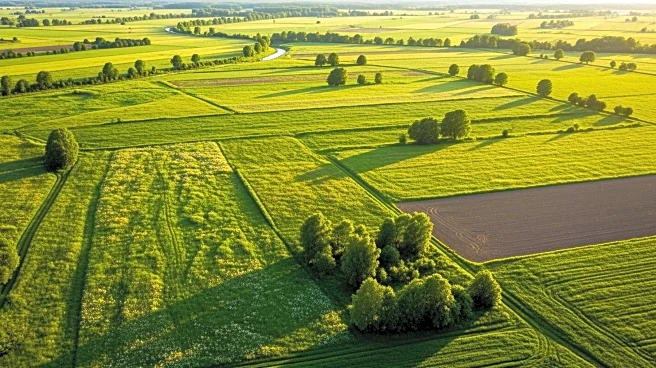What's Happening?
A recent study has examined the effects of different land use types on soil microbial biomass and respiration. The research focused on forest, pasture, and riparian ecosystems, revealing significant differences
in microbial properties and stoichiometric parameters. Forest soils were found to support more active microbial communities compared to pasture and riparian zones, with higher levels of microbial biomass carbon (C mic) and nitrogen (N mic). The study highlighted that forest soils exhibited the highest microbial respiration rates, which are crucial for maintaining the carbon cycle within the soil ecosystem. The findings suggest that land use significantly impacts soil microbial activity, with forest areas providing more favorable conditions for microbial decomposers due to higher organic matter inputs.
Why It's Important?
Understanding the impact of land use on soil microbial activity is vital for environmental management and conservation efforts. Soil microorganisms play a crucial role in carbon and nutrient cycling, ecosystem stability, and climate regulation. The study's findings underscore the importance of preserving forest ecosystems, which support higher microbial activity and contribute to soil fertility. This research can inform land management practices aimed at enhancing soil health and mitigating climate change effects. By recognizing the ecological significance of microbial biomass, policymakers and environmentalists can develop strategies to protect and restore forested areas, ensuring sustainable land use and ecosystem services.
What's Next?
Future research may focus on exploring the long-term effects of land use changes on soil microbial communities and their role in carbon sequestration. Additionally, studies could investigate the potential of afforestation and reforestation efforts to enhance soil microbial activity and improve ecosystem resilience. Policymakers might consider integrating these findings into land use planning and conservation strategies to promote sustainable development and environmental protection.
Beyond the Headlines
The study highlights the complex interactions between soil chemical and biochemical properties, which can either enhance or hinder microbial activity. These findings suggest that land use changes can significantly alter soil health and fertility, impacting agricultural productivity and ecosystem services. The research also emphasizes the need for comprehensive soil monitoring programs to assess microbial activity and inform sustainable land management practices.











